Recent Fire Damage Posts
Plan your fire escape routes now
5/2/2022 (Permalink)
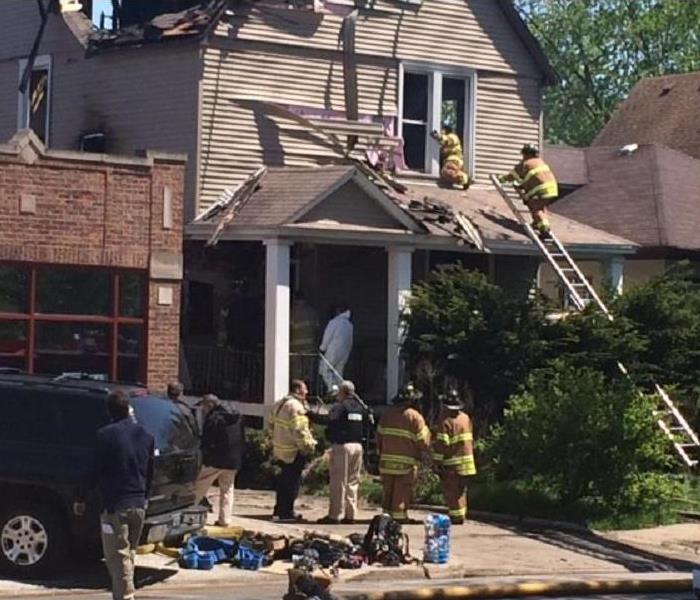 A fire, whether at home or work, can be dangerous if an escape route is blocked.
A fire, whether at home or work, can be dangerous if an escape route is blocked.
Most of us rely on GPS to get us from point A to point B. But, if you’re home or at work, and a fire happens, do you know where to go, and the safest route to get there?
Once the smoke alarms or smoke detectors go off, you may panic a little bit, not knowing exactly what is happening. Things are happening quickly, and if there’s heat and smoke in your vicinity, you may become disoriented.
Take time NOW, to know what’s the best routes out of your home and business are. Also, does your family (when at home) or coworkers (when at work) know the routes as well? Do they know the safest place to meet?
You should practice the route, to make the route like second nature. Michael Jordan didn’t get to be the best NBA player without practicing. Practice the route, especially if you have kids, because you and they may only get one chance to be right if disaster does happen.
Have a safe place to meet outdoors, so that everyone can be accounted for. Don’t depend on phones to text each other, because not everyone might not have had a chance to get their phone. But, if you DO have your phone, and are unable to get to the safe place, then by all means text or call right away.
SERVPRO Bedford Park/Burbank wants everyone to be safe when disaster strikes. Once everyone is safe and accounted for, THEN call the fire cleaning experts at 708-430-3600.
Are soot and smoke on the menu?
4/22/2022 (Permalink)
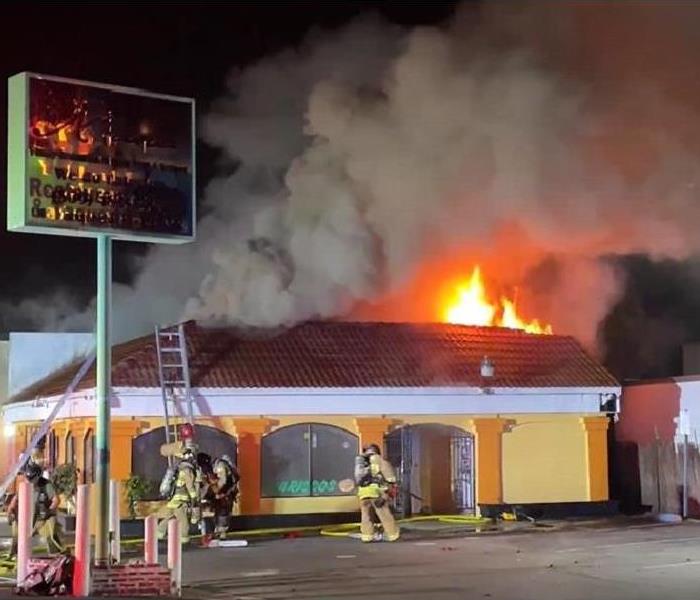 Fire, soot, or smoke damage your kitchen? Call SERVPRO right away!
Fire, soot, or smoke damage your kitchen? Call SERVPRO right away!
Like everyone else, I like to eat out at a nice quiet restaurant. But the last time I checked, smoke and soot were NOT on the menu.
So, what happens when a restaurant has a fire? Will it be closed long, or reopen quickly?
And it doesn't have to be just a restaurant, it could be your kitchen as well.
Here at SERVPRO Bedford Park/Burbank, we understand that no one wants to be displaced for any extended amount of time, whether it's cooks and wait staff at a restaurant, or you at home. That's why, as soon as the call comes in, we spring into action to quickly assess what was affected by not only the flames, but by the smoke as well. Smoke and soot particles can travel some distance from the actual fire (think of the wild fires on the west coast; sometimes we see smoke in the sky here in the Midwest).
After we determine what was damaged, we then think about how to clean it. For example, drywall with smoke staining cannot be cleaned by simply spraying a cleaner on it and wiping it away. The cleaner may actually set the stain, making it permanent.
If fire, smoke, and soot has damaged your kitchen, call the fire experts at SERVPRO Bedford Park/Burbank at 708-430-3600. We're available 24/7/365 to help you out.
Grilling safety tips
3/23/2022 (Permalink)
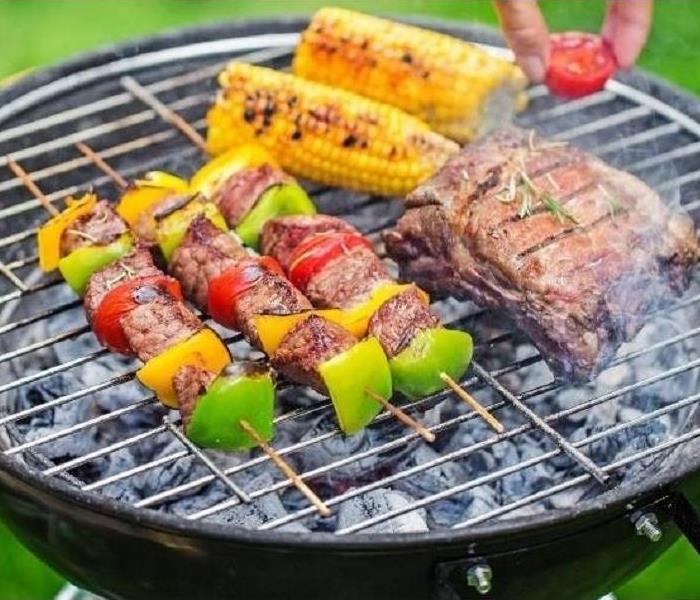 Enjoy grilling this season, and be safe!
Enjoy grilling this season, and be safe!
Warm weather has finally arrived, and cooks from all over the area will be getting out there grills. Here's a few safety tips:
- An outdoor grill should be just that - used outdoors. Never use a grill in a garage or carport. It's not only dangerous, but the soot can stain the structure.
- Place the grill on a flat, even surface. Cooking on an uneven surface is risking a tip over, but also invites the hot dogs to roll right off the grill.
- Keep the grill at least eight feet away from any structure, the further the better. Like the wildfires out west, it takes just one flareup to jump any containment you think you had.
- Check for leaks in gas grills. Spray soapy water on hoses and connections. Any bubbling means you have a leak.
- Open gas grill lids prior to turning on gas. Fumes can build up and create a fireball when lit.
- Keep all flammable items away from the grill. Starter fluid, umbrellas, and even loose clothing can catch on fire if the flareup's large enough.
- Do not leave grills unattended while cooking. Kids or pets can accidently touch the grill and get hurt, or knock the grill over altogether. Approximately 2000 children under five are hurt each year because of this.
- Keep a water spray and/or fire extinguisher close by to control flareups.
- Clean the grill after each use, to prevent grease build up.
Happy grilling!
We can deodorize furniture and contents
2/11/2022 (Permalink)
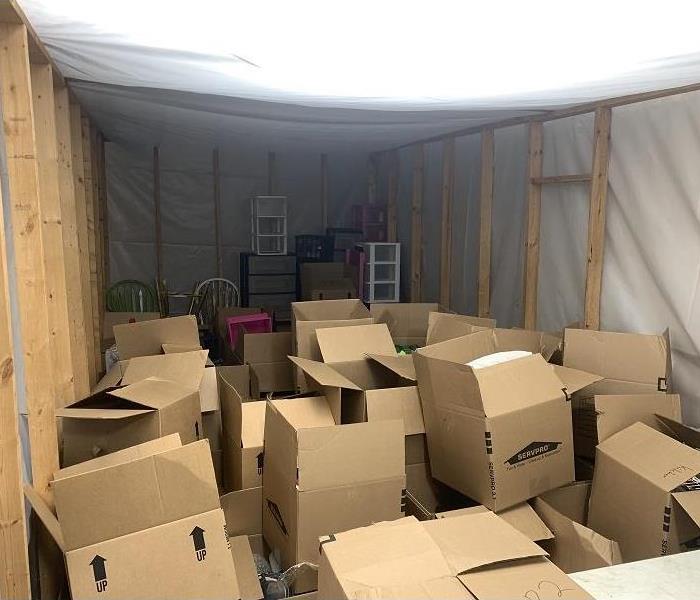 This hydroxyl chamber is ready to deodorize furniture (towards the back) and boxes and boxes of contents, including books.
This hydroxyl chamber is ready to deodorize furniture (towards the back) and boxes and boxes of contents, including books.
Is there any better smell than a pie cooking in your oven? Is there anything worse than smoke smell throughout your house, reminding you that you suffered a fire loss?
Generally, SERVPRO Bedford Park/Burbank can get the smoke smell out of structures in your house. But what about your furniture? Contents?
We will box up your items that have been smoke damaged, bring them to our secure warehouse, and clean them. Then, there are put into a chamber with a hydroxyl machine running.
Hydroxyl machines change the molecular structure of the air for just a fraction of a second, but that new molecule works to destroy smoke particles hidden in fabrics, paper products, etc. It almost works like magic!
Once all parties are satisfied that no smoke smell exists, then we bring your items back to your now clean and deodorized home.
Hydroxyl machines are just one part of the arsenal of equipment used to help restore your home or office after a fire, water damage, mold, or even biohazard damages.
Have you suffered a fire or smoke damage? Don't hesitate and call the fire experts at SERVPRO Bedford Park/Burbank at 708-430-3600. We have the equipment, manpower, and experience necessary to handle your loss!
Using the proper technique for fire damage clean up
9/9/2021 (Permalink)
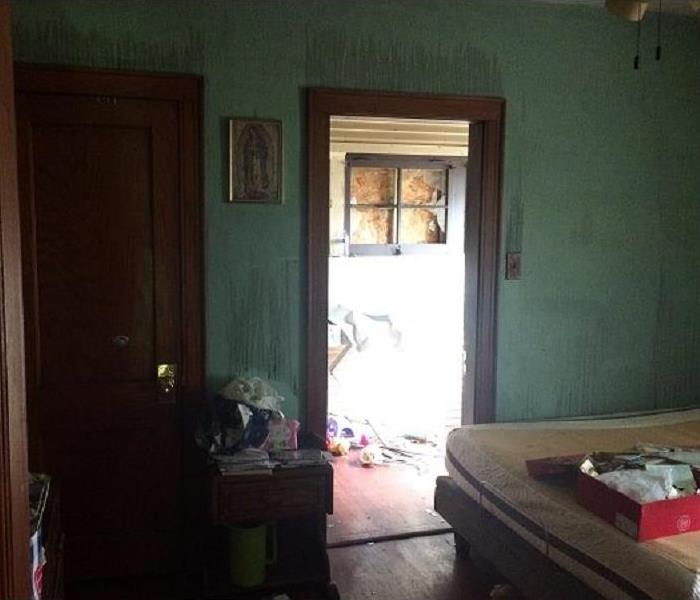 Notice the soot staining on the walls. Using household cleaners is not only very time consuming, but may set the staining, making the situation worse
Notice the soot staining on the walls. Using household cleaners is not only very time consuming, but may set the staining, making the situation worse
As you may know, September is National Preparedness Month, and, good for you, you have made an emergency kit, full of items in case of emergencies. You have extra cash, water, medicines, and clothes all stored away in a water proof container.
But, just because it’s in your kit doesn’t mean it’s right for every situation. For instance, you have a jack in the trunk of your car. That’s great, but it doesn’t help you put gas in your automobile. Or maybe you have an electric can opener in your survival pack, but it won’t work in there’s no power. You need the right instruments for the right situations.
Let’s talk about fire damage clean up for a second. Having a cleaner like 409 or Mr. Clean handy is wonderful, but if you tried either of these products to remove smoke and soot stains from drywall, you may set the stain permanently. Or using your regular washing machine to clean heavily smoke-stained fabrics may end up doing the same thing, and ruin the clothing.
SERVPRO Bedford Park/Burbank has the proper protocols and equipment to handle all your fire and smoke issues, from removing smoke staining from drywall to eliminating the smoke smell from enclosed rooms.
Suffered a fire in your home, and not quite sure what to do? Here’s a suggestion: call the cleaning and deodorization experts at SERVPRO Bedford Park/Burbank. 708-430-3600. We will come out, assess the damage, and help you devise a plan to get things back together again.
What is soot?
8/13/2021 (Permalink)
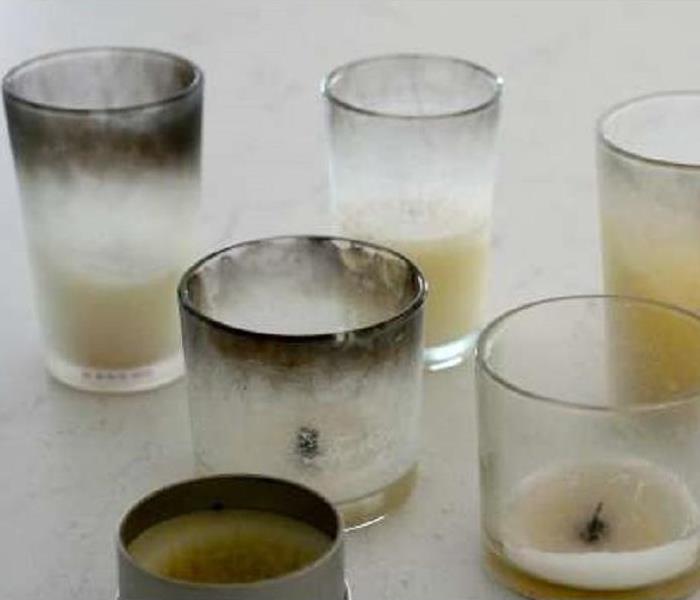 Soot is shown on the edges of these candle jars.
Soot is shown on the edges of these candle jars.
Soot is the black powder or flaky substance containing largely of carbon of organic materials that has failed to burn completely through. Very similar to smoke, but smoke is mainly a gas byproduct, whereas soot is more of a liquid/solid than a gas.
In order to burn materials, you need the following: A fuel source, heat, oxygen, and an ignition source. More information on this subject is in a previous blog on this website: https://www.SERVPRObedfordparkburbank.com/blog/post/150167/fire-smoke-damage-restoration/ingredients-to-a-fire
As materials burn, they emit smoke and soot, because most materials cannot burn 100%. Think about the ash left behind after a fireplace fire. Though the wood was dry, and the fire hot enough, there’s always some materials that cannot burn completely.
Smoke dissipates as it moves through the air, because other gasses interact with the moving smoke. Soot, on the other hand, will land and collect on mainly flat surfaces, though it can collect on walls, ceilings, and contents.
When you burn scented candles, look how the glass around the rim turns black. That is soot. You’ll notice that the soot is sticky, and not easy to clean.
Now, SERVPRO of Bedford Park/Burbank is an expert on smoke and soot cleaning, as well as deodorization. Now, we’re not going to clean your candle jars, but we can clean your walls, ceilings, and contents if you were unfortunately subject to a house fire. We will also get rid of the smoke smell.
Need help cleaning up after a fire? Call the experts at SERVPRO Bedford Park/Burbank at 708-430-3600.
Fire and smoke damaged warehouse
5/28/2021 (Permalink)
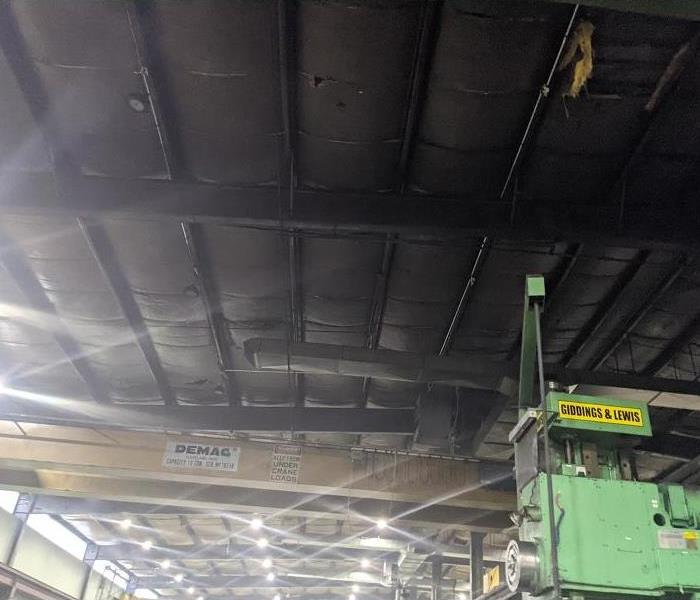 Smoke and soot has damaged this warehouse ceiling. Soot particles can disrupt the machinery below if not cleaned properly.
Smoke and soot has damaged this warehouse ceiling. Soot particles can disrupt the machinery below if not cleaned properly.
When a local warehouse had a piece of machinery catch on fire, it caused some fire damage, but it sent smoke and soot throughout the building, including the offices, hallways, lunchroom, etc.
Smoke and soot particles stained the walls, ceilings, and some of the equipment inside that facility. SERVPRO Bedford Park/Burbank was called.
When we arrived, we walked through with the property manager, discussing what areas were the highest priorities, which area(s) could wait until later, and what damaged structure can be cleaned instead of being replaced. Cleaning materials is more cost effective, and less disruptive, than replacing said items.
Part of the discussion also included that the cleaning had to be done second shift (from 4:00 pm to midnight). Working within those parameters isn't a problem for SERVPRO.
Covering machines in the area where we were going to be cleaning was the first item on our list each day. We couldn't allow dust, smoke, or soot to cause secondary damage to operating machines while we cleaned. And before we left for the night, we had to ensure that all debris was picked up and disposed of properly, again to prevent secondary damages throughout the warehouse.
Did you suffer smoke damage to your home or business? Call the fire clean up experts at SERVPRO Bedford Park/Burbank at 708-430-3600.
After the fire is out
5/12/2021 (Permalink)
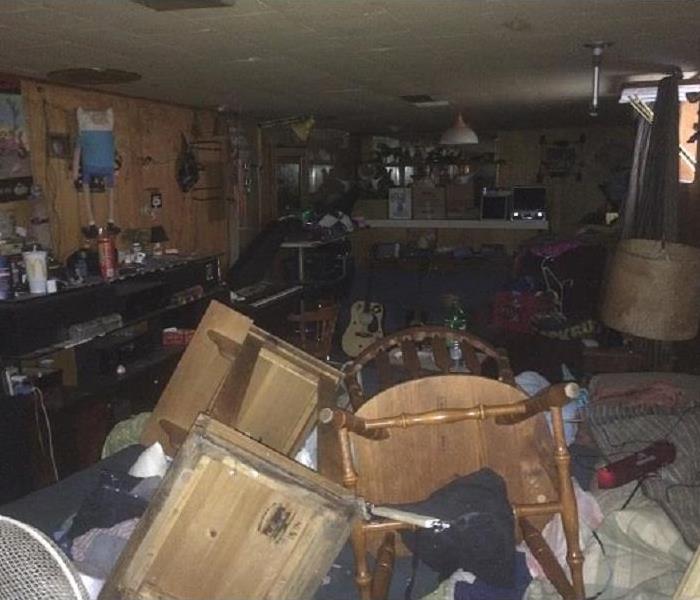 Many things to consider here: water damage, fire and smoke damage, structural integrity loss, and which contents to save or discard.
Many things to consider here: water damage, fire and smoke damage, structural integrity loss, and which contents to save or discard.
Your home or business suffered a fire loss. The fire is out. Everyone has been accounted for (and hopefully safe). The fire department has left.
You stand there, looking at the mess that is left. Walls and ceilings have been damaged. Water from the firefighting efforts soak many areas, and pool in the lower reaches of the building. Soot is everywhere. Contents have been strewn all over.
First and foremost, the water has to be extracted, and all wet items that cannot be saved must be removed and disposed, otherwise mold may be the end result. In fact, all items that have been permanently damaged, or damaged to a point where repairing it isn't feasible, must be discarded as well. This includes contents, structure, and personal items.
What is left is the physical cleanup of the soot. Simply using your favorite household cleaner will not work, especially on painted surfaces such as drywall. In many cases, the cleaner will just make matters worse, setting the stain to the extent where that wall cannot be cleaned anymore, and will have to be painted.
SERVPRO Bedford Park/Burbank are experts in cleaning methods on fires. We have the proper protocols and equipment to rid your property of all that nasty soot mess, and return it back to preloss (or better) condition.
Have a fire at your property? Call the cleaning experts at SERVPRO Bedford Park/Burbank at 708-430-3600 right away!
Having a home inventory helps after a fire
3/29/2021 (Permalink)
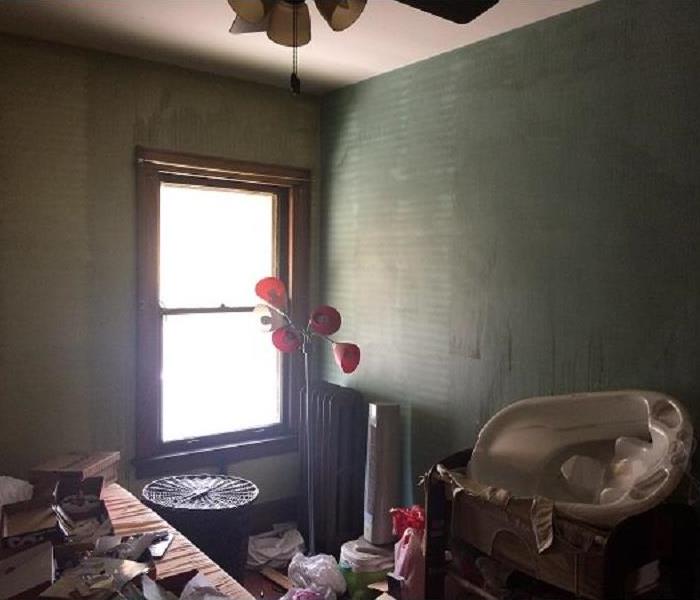 Making sure you have all your possessions accounted for can be difficult after a fire.
Making sure you have all your possessions accounted for can be difficult after a fire.
Let's start with a question: Can you name everything that is on your nightstand in your bedroom? You see that nightstand every day, probably several times a day. If you had to write down everything that is on there, could you remember it all?
Now, imagine trying doing this after something as traumatic as a fire in your home.
Chances are, you'd probably forget something. We all would.
I use the example of a nightstand to highlight how easy it is to miss something. What you may forget may be something insignificant, or it could be something very important of value to you.
The best thing you can do right now is to do a complete home inventory. It doesn't take too long, and it could be very helpful if something as unthinkable as a fire happens to you.
Taking pictures is fine, but video works best. Going room by room, scan the room from a corner from left to right, then move to the opposite corner and repeat the process. Add commentary as you video, such as: "I bought this signed baseball jersey in 2021 for $600 at that charity auction."
When all the rooms are completed, email the video file and pictures to yourself. This way, you'll have the date you performed the inventory (if it's several years old, you may want to update it), and you'll have access to it no matter where you are.
SERVPRO Bedford Park/Burbank has performed many fire/smoke mitigations. We know the proper ways to clean structure and deodorize rooms. A simple call to 708-430-3600 will start the process.
Treat candles with extreme care
2/15/2021 (Permalink)
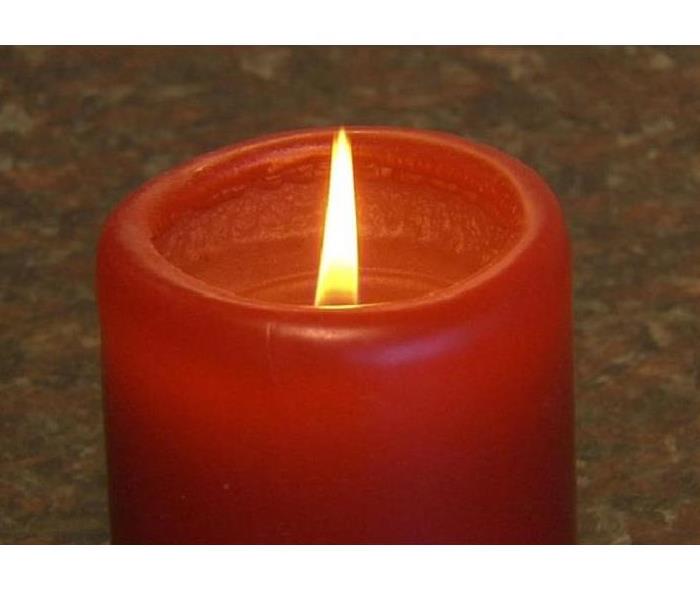 This candle may look elegant, but you let your guard down, it can become deadly.
This candle may look elegant, but you let your guard down, it can become deadly.
Candles. They provide ambiance with subtle lighting in a dark room. They give off a nice, romantic glow.
But, we are talking about an open flame, in a room with lots of combustible items. Care must be taken when using candles.
- Think about where you want to place the candle(s). They should be greater than one foot from anything that can be combustible: drapes, bedding, towels, etc. They should also be placed in a place where children nor pets can accidently knock it over.
- Use caution when lighting the candle. Make sure loose clothing, hair, or combustibles are clear as you light the candle, whether you are using a match, lighter, or other starter.
- Do not burn the candle all the way down. Many times, candles are in jars, and if you burn them all the way down, the candle heat may crack the jar.
- Don't leave a candle unattended. Do not leave a room for an extended period of time while the candle is burning. Also, do not fall asleep while a candle is burning.
You may notice, as the candle burns down, that the rim of the jar is turning black. Then you notice that the closest wall and the ceiling directly above is getting black as well. That is soot from the candle. If you try and clean it yourself, you may end up setting the stain, whereby covering with paint is the only answer.
SERVPRO Bedford Park/Burbank is an expert at cleaning up smoke and soot residues, whether from a fire or from cigarette or candles. Give us a call at: 708-430-3600.
Home fires can be dangerously hot
9/30/2020 (Permalink)
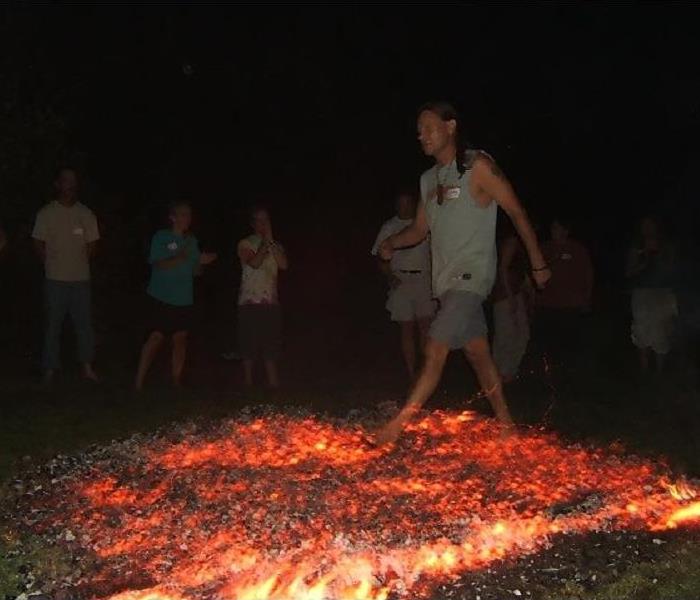 It takes a brave soul to walk over these hot coals, knowing the temperatures contained within.
It takes a brave soul to walk over these hot coals, knowing the temperatures contained within.
It’s a cool autumn evening, and you are sitting in front of a fireplace fire. The temperature of the fire in the fireplace is greater than 500 degrees Fahrenheit. Or perhaps you are standing next to the grate where the output of the furnace is. That temperature is about 120 degrees Fahrenheit. But, what temperatures are we talking about when there’s a house fire?
Once a room catches on fire, temperatures inside that room rise dramatically fast. A minute or so after the room is ablaze, the temperature at floor level reaches 100 degrees Fahrenheit, 600 degrees at head level, and over 1100 degrees at ceiling level. For comparison:
- Tin melts at 232 degrees
- Lead melts at 327 degrees
- Wood and paper products catch fire at 450 degrees
- Gasoline catches fire at 480 degrees
- Aluminum melts at 660 degrees
- Glass becomes malleable at 1020 degrees
- And charcoal burns at 2000 degrees.
If you are caught in a home fire, you should:
- Try and stay calm
- Crawl low on the floor, where the temperatures will not scorch your lungs
- Feel doors before opening. If they are hot, there could be flames on the other side
- If your clothes catch on fire, cover your face and roll around, trying to smother the flames.
- If your escape routes are all cut off, go back to a room, close the doors, block the vents and around the door with towels, linen, etc, and signal for help
Once the flames are out, and everyone is safe, there’s a mess to clean up. SERVPRO of Bedford Park/Burbank is here to help! Call the experts in cleaning at: 708-430-3600.
How far can smoke travel?
9/22/2020 (Permalink)
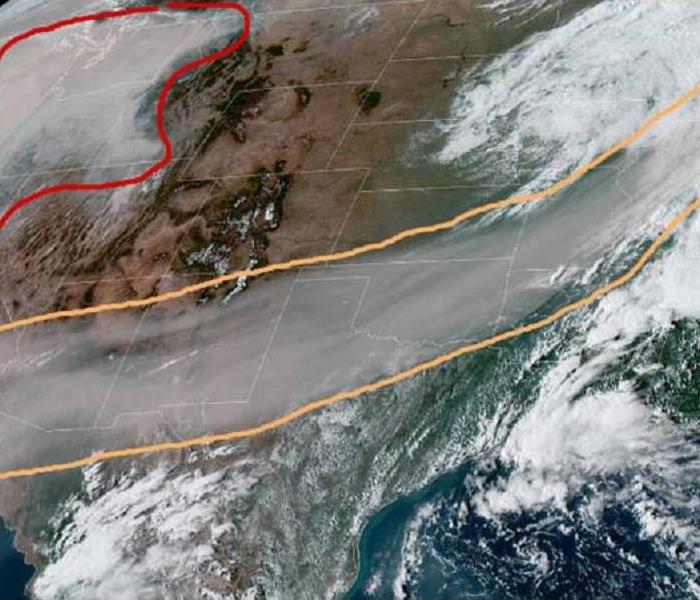 Smoke from the California wildfires has dampened our sunshine the last couple of weeks.
Smoke from the California wildfires has dampened our sunshine the last couple of weeks.
Unfortunately, you had a fire in your home. It could have been a kitchen fire, with its sticky residues because of the animal fats that were burning. Perhaps it was a dryer fire. Or maybe it was a fireplace fire that got a bit out of control, with light soot and ash that seems to get everywhere. Even though the flames were contained to one or two rooms, how far did the smoke travel?
Smoke and soot use the hot air escaping the flames to travel about. Because hot air is much lighter than cool air, it travels up towards the ceiling quickly. Then the air currents will move the smoke anywhere throughout the home as the air currents allow.
Because smoke and soot follow these air currents, they will get into very tiny cracks and crevices; into drawers, closets, rooms, and wall cavities, even though doors are closed and drawers are shut. These areas are not airtight, so it doesn’t take much to push smoke and soot particles into the tiniest of places.
As the air currents get further from the actual fire, they lose some punch and don’t flow as quickly. The soot particles then become too heavy for the air to keep them up, so they land on the closest flat surfaces. Counters, desks, sills, etc are the most common areas for these particles to land.
As to the original question: How far will smoke travel? The answer is quite evident this month, as several days in a row we saw smoke from the California wildfires mask some of our sunshine. That milky haze in the sky was actually smoke that has travelled hundreds of miles on the jet stream. Smoke has even made it to the east coast, where New York City had some smoke from California in their skies.
Smoke damage in your home? Call the cleaning experts at SERVPRO Bedford Park/Burbank at 708-430-3600. We have the proper tools to check for smoke, and know how to clean it once it’s been identified.
Can smoke from a fire be dangerous?
6/9/2020 (Permalink)
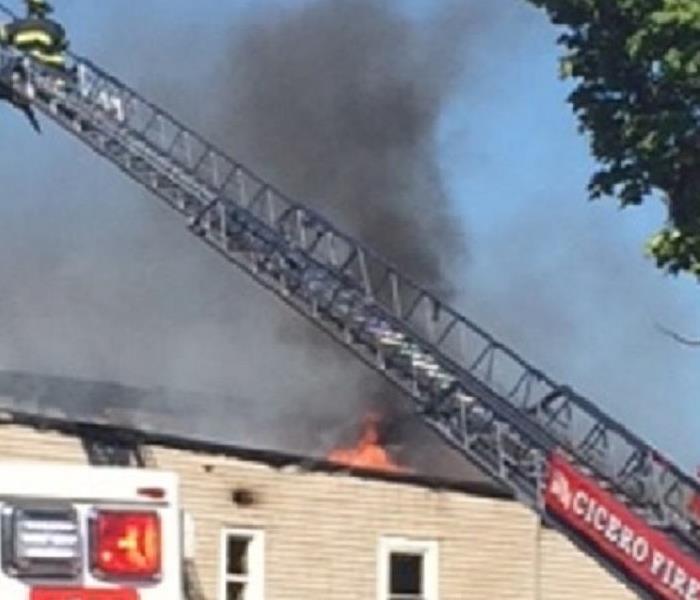 Where there's fire, there's smoke. Is there anything dangerous inside the smoke?
Where there's fire, there's smoke. Is there anything dangerous inside the smoke?
It’s a chilly evening, and you have a roaring fire going in the fireplace. There is a little bit of smoke that doesn’t quite make it up the chimney. The room smells pretty good. Are there any dangerous chemicals or particulates inside the smoke?
Now, that roaring fireplace fire gets out of hand, and the room catches on fire. There is a lot of smoke. Are there any differences in the composition of the two smokes?
Both smoke and ash are the byproduct of materials that do not completely burn in a fire. One reason the material does not burn completely is that the oxygen source may have been cut off; fires need oxygen to burn. Another possible reason materials did not burn is that the fuel source may have been hindered (like firemen throwing water on a fire).
There are many items and chemicals in smoke. Just a few of them are:
- Carbon (from the physical burning of materials)
- Carbon Dioxide
- Carbon Monoxide
- Acidic Gases
- Benzene
- Stryrene
- Ash
- Water Vapors
All materials, whether natural or man-made, have some water content in them. As the fire consumes that material, water vapor is released. The chemicals that are also released in fires, attach themselves to the water vapors and are carried away with the wind currents.
Fighting a house fire should be left to the professionals, the firefighters. You should exit a building that is burning as quickly and safely as possible. But, sitting downwind of a fireplace or fire pit fire and breathing in the smoke, can also be dangerous. This is true, especially if you have heart, lung, or breathing issues. Wearing a dust mask, or even a surgical mask, will not offer much protection.
If your home suffered some smoke damage, whether from a fireplace fire that got a bit out of hand, or a room or house fire, call the experts at fire cleanup, SERVPRO Bedford Park/Burbank. We have the knowledge and protocols to save all items that can be restored, safely and quickly.
Do's and Dont's DURING a fire
5/15/2020 (Permalink)
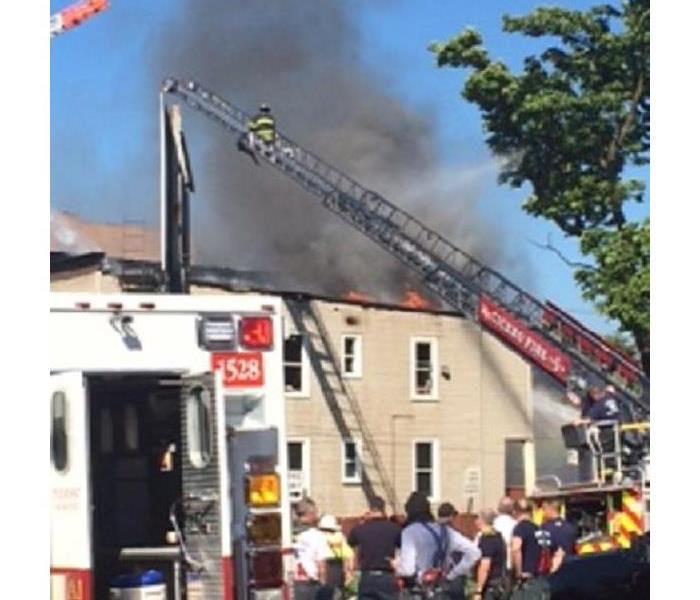 Fire happens quickly and gives you precious few moments to escape. SERVPRO Bedford Park/Burbank can help with the cleanup and deodorization.
Fire happens quickly and gives you precious few moments to escape. SERVPRO Bedford Park/Burbank can help with the cleanup and deodorization.
Stay low! Stop, drop, and roll!
We teach our kids these principles early on, for what to do if involved in a fire. But, do you know WHY you should stay low in a fire?
As the fire rages, extremely hot temperatures and toxic gases flow up towards the ceilings. These temperatures can reach several hundred degrees very quickly and burn your lungs, making it impossible to breathe. And toxic gases, coming from the combustion of burning materials and structure, can damage your lungs in a matter of a few breaths. Further, the fire is also consuming oxygen, an element you cannot live without.
In preparation of the possibility of fire, you should know at least 2 ways of of the building, in case one exit is blocked due to fire. Know where fire extinguishers are located, as they may be your lifeline out. And check smoke detectors regularly.
Here are a few of the do's and don'ts for a fire:
- Evacuate the building as quickly and calmly as possible.
- Meet at the rally point outside that has already been predetermined to be safe.
- Use the fire extinguisher only to help you evacuate. Do NOT try to be a hero and fight the fire.
- Do not go for personal items, such as collectibles or keepsakes, as it wastes time and you may lose your escape route. If you are dependent on medications daily, have a bag ready to grab in cases such as this.
- Wait until you are safe outside before calling the fire department.
If you were unfortunately involved with a fire, call the fire cleanup experts at SERVPRO Bedford Park/Burbank at 708-430-3600. We can salvage structure and contents that can be salvaged, deodorize and clean smoke and soot damage, and get you back to living as normal a life as possible quickly.
Can I use my outdoor grill indoors?
4/17/2020 (Permalink)
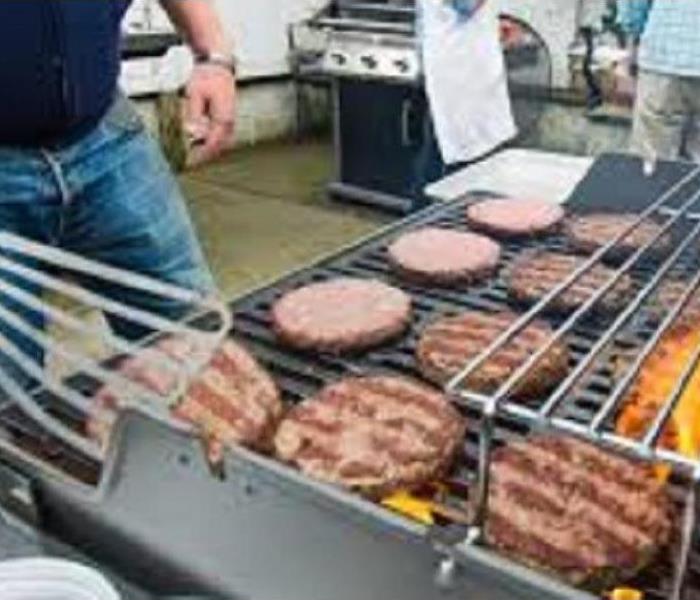 There's nothing like the taste of grilled foods. But, grills need to remain outside.
There's nothing like the taste of grilled foods. But, grills need to remain outside.
Now that the warmer weather has finally arrived, it's time to think about the great outdoors, and that will include grilling. But, it's raining today. Can I use my outdoor grill inside, like in my garage?
The answer is no. Outdoor grills are only meant for use outside, and that also rules out using your grill inside a garage.
- Grilling indoors can cause a build up of carbon monoxide gasses, due to the lack of ventilation inside (if you're grilling inside because it's raining outside, you'll probably have all the windows closed anyway).
- Grills tend to put out much more heat than ovens, so there's also a fire hazard to consider. Curious children or pets may injure themselves due to the close proximity of the grill.
- If your grill has a slow gas leak, dangerous gasses can build up, and may not be detectable by your carbon monoxide detectors.
- Not as serious of an issue, but smoke staining on walls, ceilings, and contents may occur if you grill indoors. using household cleaners to try and remove the staining can actually set the stain.
So, please keep outdoor grilling outside. And, if you have an issue with smoke staining, call the fire exerts at SERVPRO Bedford Park/Burbank at 708-430-3600. We can clean, deodorize all your fire and smoke mishaps.
Soot particles can be hazardous, and tough to clean
2/26/2020 (Permalink)
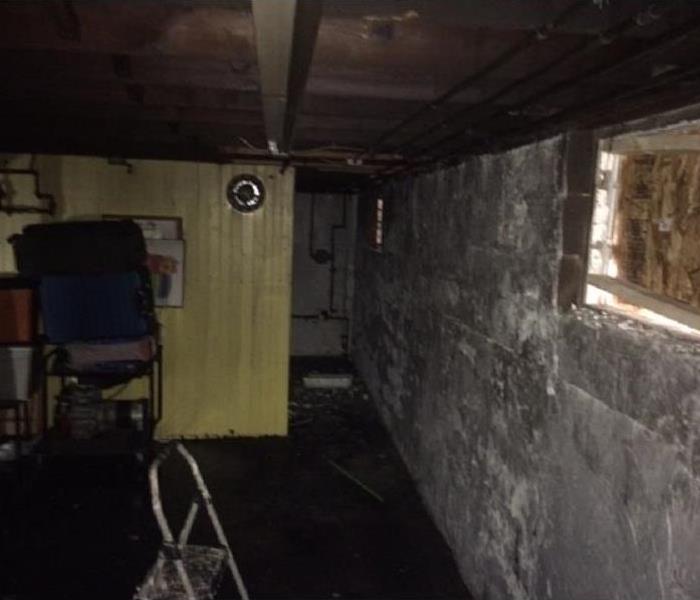 Though tempting to do the work yourself, you may cause more damages if you don't know exactly what to do.
Though tempting to do the work yourself, you may cause more damages if you don't know exactly what to do.
Once the fire is extinguished, there will be smoke and soot residues left over that will need to be dealt with. But, precautions will have to be taken when dealing with smoke and soot.
Soot is the product of incomplete combustion of materials during a fire. Soot is very acidic, and could be hazardous to breathe in great quantities. A mask (or better yet, a respirator) should be worn anytime you plan to spend extended time in and around these areas.
If you see soot or smoke damage on walls or ceilings, do not touch it. The oils in your fingers touching the soot could possibly set the stain in drywall, thereby making it almost impossible to clean – these walls will have to be painted.
Tracking soot from a room that has soot and contaminating a room that did not already have soot is a common issue. Homeowners in a haste to move personal belongings from a smoke damaged room to a clean room can bring soot particles with them, creating a larger area to clean and disinfect.
If you have suffered smoke damage from a fire, it’s best to call the cleaning experts at SERVPRO Bedford Park/Burbank. They have the knowledge and expertise to contain the spread of soot, from the evaluation of the damage through to the final touch ups of cleaning. Call 708-430-3600 to set up an appointment right away.
Top causes of home fires
11/8/2019 (Permalink)
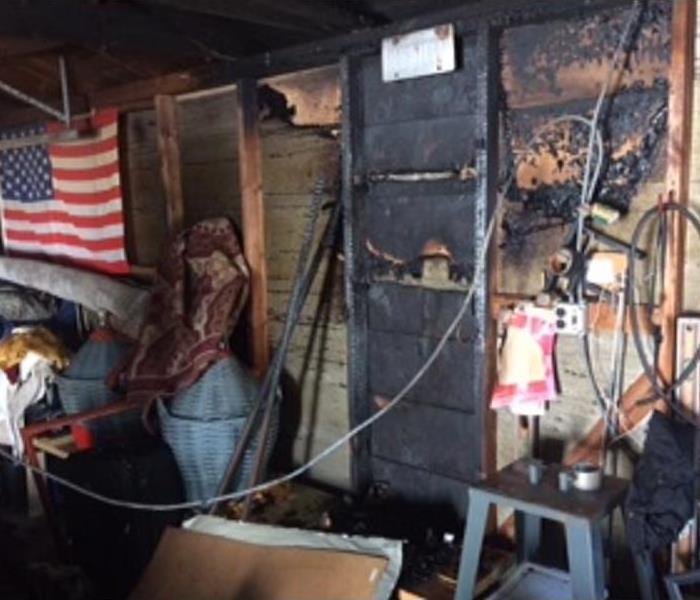 Fires can happen quickly in any part of your home, including this garage.
Fires can happen quickly in any part of your home, including this garage.
Now that we're in the fall season, and the holidays fast approaching, chances increase that you may suffer a fire damage inside your home. Kitchen fires are more prevalent because of more cooking for the holidays. Heating issues also further chances of fires.
Let's take a look at some of the major causes of fires inside homes:
- Cooking. Cooking is far and away the most common cause of home fires in the US. It accounts for 48%* of all fires, and averages about 172,000* fires each year. Unattended cooking, having flammable materials too close to stoves or ovens are just a sample of why fires get started in the kitchen.
- Heating. Space heaters or fireplaces account for about 52,000* home fires each year. Having items too close to the heat source is just one way this may happen.
- Electrical. Accounting for an average of 35,100* home fires per year. Overloaded outlets or frayed extension cords are just two of the main culprits.
- Smoking. Falling asleep while smoking is the main cause of the 18,100* home fires in an average year.
- Candles. 8,200* yearly fires is a comparatively small number compared to the others in this list, but it can be the most easily preventable as well. Candles being knocked over, or items too close to the flame are major causes of this type of fire.
Also, 58%* of all fire injuries are caused by people either fighting the fire outright, or trying to enter/exit a fire for a rescue. Have a plan, and practice it with children, to know what to do if there is a fire in your home.
* = NFPA statistics.
Space heater safety tips
10/11/2019 (Permalink)
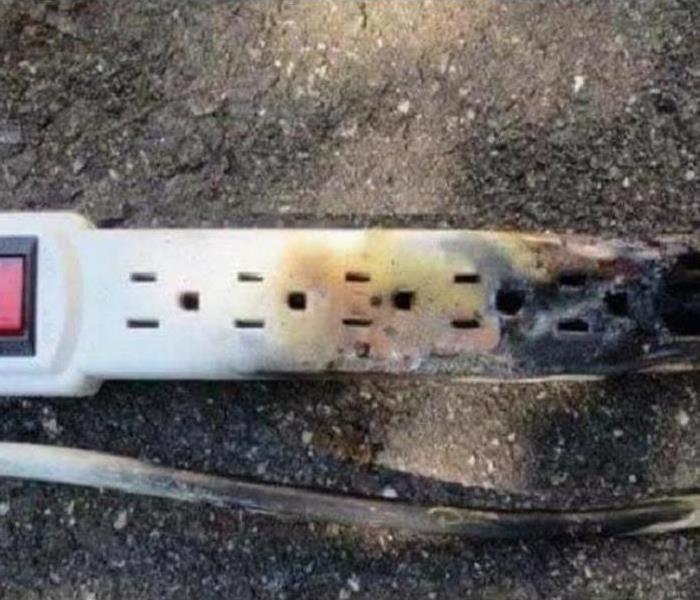 A burnt out power strip, caused by having a space heater plugged into it.
A burnt out power strip, caused by having a space heater plugged into it.
Now that the cold weather is upon us again, it may be time to bring out that portable space heater. As a refresher, here's a few safety tips:
- Check the wiring and connections. If you see any damage or fraying, do not use the space heater.
- Plug space heaters directly into the wall socket. Do not use extension cords or power strips, which can overheat over time and cause a fire.
- Place space heaters on a flat and level surface. Do not place on desks, tables, or other furniture. Also, avoid carpeting as well.
- Keep rugs, drapes, bedding, etc a minimum of three feet away from the front of a space heater.
- Do not place in a high traffic area or doorway, where it can be accidentally tipped over.
- Keep children and pets away from the space heater.
- When leaving a room or sleeping, always shut it off; never leave it unattended.
- When leaving the building to go to work, school, shopping, etc, always unplug the machine for safety.
- When storing a space heater, always make sure it cools completely before putting it in a box, closet, etc.
Supplemental heat like this can take the nip out of the air, but then again, so could a fire. Plan accordingly, so you can enjoy the former without suffering the latter.
Have you developed a fire escape plan?
7/3/2019 (Permalink)
 NOW is the time to develop a fire safety plan, be it at work or at home.
NOW is the time to develop a fire safety plan, be it at work or at home.
You’re sitting in your easy chair, watching TV and having a lemonade. The kids are playing upstairs in their rooms. Suddenly, the smoke detector goes off. Do you know what to do? Do the kids know what to do?
Or
You’re at your desk at work, checking emails from the weekend. Suddenly, the fire alarm goes off. Do you know the safest route out?
In either case, being unsure of what to do or where to go may cost valuable seconds, seconds that could mean being injured instead of being safe. If there was a plan in place, and posted (if not practiced), this situation should have a favorable outcome, healthwise.
No one plans to have a fire at work nor at home. But, you still need to be prepared in case it does happen.
At home, know the safest routes out from any room in the house. Know the place safely outside where the family should meet. And make sure the kids know the basics as well.
At work, if your business does not have a safety officer, you should take it upon yourself to know the quickest, safest routes outside. If you are several floors up, know that the elevators should be avoided, and alternate routes have to be chosen. Have a designated location where you and your coworkers can meet.
In case of a fire, getting out and safe should be your only priority. Fighting the fire should only be done if it endangers you or someone you know is trapped. No one needs to be a hero; leave the firefighting to the professionals.
Infamous fires throughout history
5/30/2019 (Permalink)
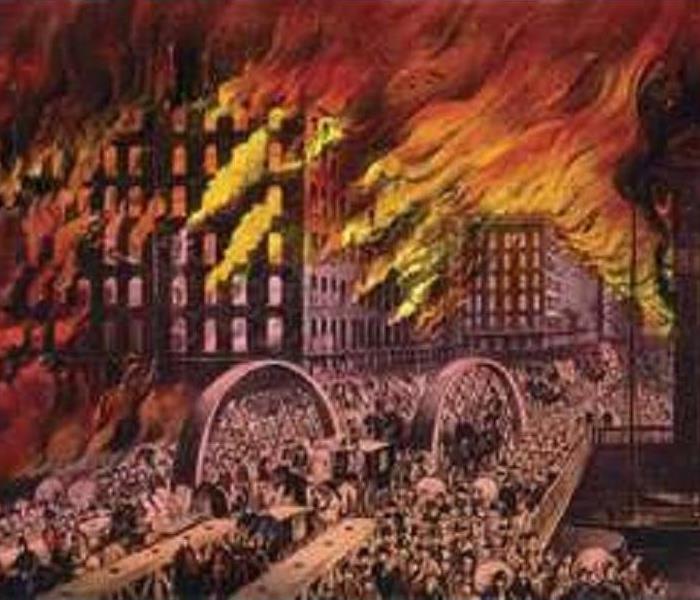 No one plans to have a fire, but if it happens, SERVPRO is ready to help!
No one plans to have a fire, but if it happens, SERVPRO is ready to help!
Some of the more famous fires in history:
- Rome 64 AD. Approximately 70% of Rome burned, and no, Nero did not fiddle while it burned. The fiddle wasn’t invented for another 100 years. But, Nero did build a huge palace for himself on the ashes in the best section in town.
- Great Chicago Fire Oct, 1871. 250 people lost their lives, and 17,000 structures were lost. People knew they were going to lose their houses, so they dragged the furniture into the street to try and save it. It only made the fire spread faster, and clogged the streets so Fire Departments and ambulances couldn’t get through.
- Great Boston Fire Nov 1872. Only 20 were killed, and just 776 buildings were lost, but this fire still brought Boston to its knees. This fire practically took out the entire business district, and no one could work for quite some time.
- Iroquois Theater Fire Chicago Dec 1903. Just one month after it opened, a fire started above the stage, blocking the exits of the top two levels of the balcony. 602 people lost their lives.
- Our Lady of the Angels School Chicago Dec 1958. This fire started in the basement less than an hour before school was to let out for the day. By the time some teachers knew what was happening, it was already too late, as exits were blocked by fire and heat. 92 children and three nuns perished, some from injuries resulted from children jumping from upper floor windows.
- The Camp Fire California Nov 2018. By far the largest wild fire in California history, this fire consumed about 240 square miles, killed 86 people, and destroyed 18,804 structures.
- Notre Dame Cathedral Paris Apr 2019. Built in the 12th century, and repaired many times since, this structure was still mainly wood, metal, and stone. And even though they have a fireman on site 24/7/365, the fire still spread too quickly to save the spire and one of the towers. Current estimates state that repairs to the cathedral will take 20 years to complete.
What do these fires (and really all fires) have in common? Not a single person planned on having a fire at that time. Fires come with no warning whatsoever. With storms, the weatherman can predict danger ahead of time, but not with fires.
If you had a fire in your home or business, not only will you have water damages (or fire extinguisher dust for much smaller fires), but also soot will travel and accumulate in areas far away from the actual flames.
Call the experts at SERVPRO of Bedford Park/Burbank at 708-430-3600. We have the knowledge and experience to know where to look and the best way to clean it, if it can be salvaged.
Ingredients to a fire
5/2/2019 (Permalink)
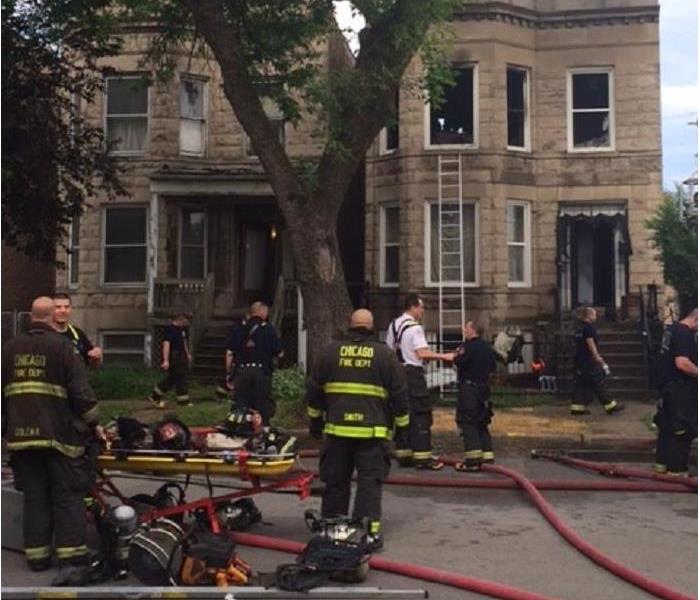 It takes the right ingredients to create a fire.
It takes the right ingredients to create a fire.
Question: When is a fire like a cake? Just like a cake, fires need certain ingredients to complete. Remove just one of the ingredients, and it just doesn’t work.
The ingredients fires need are: fuel, heat, oxygen, and an ignition source.
Fuel: anything combustible, like paper, wood, dry grass, fabrics, etc. Generally, anything that can burn easily.
Heat: A fire needs the proper temperature range to not only start, but also to keep going once it has started.
Oxygen: Like any living creature, fire needs the right air mixture to burn.
Ignition source: Matches, lightning, a toaster, etc. Anything to bring a fuel source close to its combustion point.
Once a fire has started, people fighting the fire have to control or eliminate one of the ingredients to stop the fire. In church, an acolyte places a cup over a lit candle until the candle has used up all the available oxygen. Crews fighting wildfires start a fire break; fires well ahead of the main fire, to rob the main fire of fuel. Firefighters throw water on fires, to help lower the temperatures and possibly disperse some of the fuel. Water also turns to steam, and it may disrupt the air mixture just enough to rob the fire.
There are other blogs on this site that deals with what type of fire extinguishers you need, as well as the different types of soot and residue left behind after a fire.
If you have suffered fire or smoke damage, call the experts at SERVPRO Bedford Park/Burbank. 708-430-3600. We have the expertise to make it “Like it never even happened!”
Use caution in smoke filled rooms
4/2/2019 (Permalink)
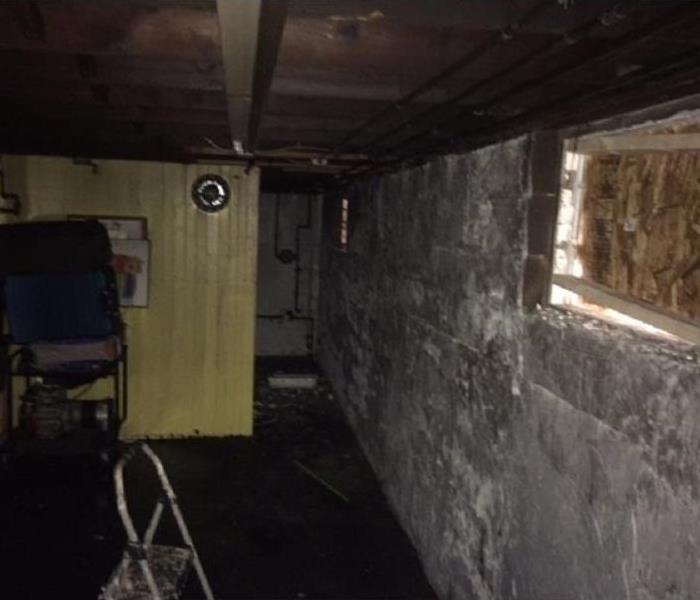 Avoid or limit moving through heavily smoke damaged rooms such as this.
Avoid or limit moving through heavily smoke damaged rooms such as this.
You've had a fire. Luckily, no one was injured. But, several rooms in the house suffered smoke and soot damage.
Your first reaction is to start going through your belongings, to see how much damage they have incurred during the fire. You start moving boxes around and rummage through drawers and closets.
But beware! Going from room to room could drag soot particles into rooms that did not have any initial damage. Repeated walking in soot-filled rooms could also embed the smoke particles into the carpets and flooring, making them harder (if not impossible) to clean.
Also, touching the walls, whether on purpose or by accident, could cause the smoke particles to stain the drywall permanently, because of the oils in your fingers.
We understand that you are in a hurry to check the status of your belongings. But just haphazardly checking items from room to room can cause more secondary damages than necessary.
Calling SERVPRO of Bedford Park/Burbank and scheduling an inspection is the correct option. We can walk through the home with you, assess the damaged areas, recommend options that you can do safely, and set up a cleaning plan.
Don't delay! Call us today! 708-430-3600.
Use caution when deep frying turkeys
11/16/2018 (Permalink)
 Take extra precautions during the holiday cooking season!
Take extra precautions during the holiday cooking season!
The holiday season is fast approaching. Images of a golden brown turkey, stuffing, cranberries, corn, and other items on the dinner table will always bring a smile to your face. And, I'll bet if you close your eyes, you can still smell the pumpkin pie fresh from the oven, cooling in the kitchen.
But, all these preparations take a lot of work. And cooking fires are the number one cause of fires during the holiday season.
SERVPRO Bedford Park / Burbank almost always get a call from a cooking disaster on Thanksgiving or Christmas. And many times it's from deep frying a turkey.
Here are some safety tips:
- Always place your deep fryer away from your home, garage, decks, and even trees. If there's a flare up, you don't want to inadvertently catch anything nearby on fire.
- Make sure the ground the deep fryer is on is level. Uneven ground may cause tipping once the turkey's weight is added to the fryer.
- Make sure your turkey is COMPLETELY thawed. Any part of the turkey still frozen will cause dangerous flare ups.
- Make sure the turkey is dry. Any moisture or drops will cause flare ups.
- Use heavy duty oven mitts when handling the turkey or the fryer.
- Have a fire extinguisher (or 2) handy and close by.
- Have our number, 708-430-3600, already inputted into your phone, in case you need us for any fire or smoke damage.
October is Fire Prevention Month
10/15/2018 (Permalink)
 No one plans for a fire, but you can plan FOR a fire.
No one plans for a fire, but you can plan FOR a fire.
In October 1871, there were many fires burning in the Midwest. The largest and deadliest was NOT the Great Chicago Fire, even though the folklore is deep with that fire, with a cow supposedly kicking over a lantern.
Since 1922, the U.S. has observed a Fire Prevention Week, the second week of the month. In 2000, we added a Fire Prevention Month.
Are you prepared for a fire, either to prevent one or escape one if one starts? Here are a few helpful tips to keep your family safe:
SMOKE ALARMS:
- There should be one on every level of your home.
- It is recommended that there be one in every bedroom, and at least one outside of sleeping areas.
- Smoke alarms should either be mounted in a ceiling, or no greater than 10" from a ceiling on top of a wall.
- Try to keep smoke alarms at least 10' from cooking areas, as there would be numerous false alarms.
- They should be cleaned periodically, and the batteries changed regularly. A good rule of thumb: when you change your clocks in the spring and fall, also change the batteries in your smoke alarms, and clean the to keep dust and grease away from openings.
FIRE EXTINGUISHERS:
- There should be one on every level of the home, plus the garage if you have one.
- There should be at least one in or near the cooking area.
- Fire extinguishers come in different purposes, so make sure you have the proper type. Type A = all purpose, while type K = kitchen use. There are other types as well.
- When using a fire extinguisher, remember PASS - Pull pin, Aim at base of fire, Squeeze trigger, Sweep from side to side.
ESCAPE PLAN:
- Have an escape plan, where there's at least two exits from every room.
- Have a meeting place outside, and away from the house, so everyone can be accounted for.
- Practice this plan with children, so they know what to do if a fire alarm goes off.
How to clean cigarette smoke
7/30/2018 (Permalink)
 Cigarette smoke has turned this white cover gold.
Cigarette smoke has turned this white cover gold.
What can you find in cigarette smoke? There are some toxic compounds, and some compounds that are carcinogenic. The most abundant compounds found in cigarette smoke are: tar, nicotine, and carbon monoxide. You will also find traces of acetone, ammonia, benzine, and formaldehyde.
A person who smokes will not leave a great deal of smoke damage to walls, furniture, drapes, etc, from just ONE cigarette. But, over time, the smoke accumulates on these objects, and will continue to stain until it is cleaned.
Tobacco smoke will adhere to all surfaces it touches, leaving a sticky, yellowish-brown substance where the smoking has taken place. SERVPRO Bedford Park/Burbank can clean years of accumulated smoke residues. Also, along with the cleaning, SERVPRO will also deodorize the affected areas. In the end, it will feel clean, smell clean, and be clean!
If you know someone who needs smoking residue removed, call the experts at SERVPRO Bedford Park/Burbank at 708-430-3600.
Machine used to get rid of odors
6/8/2018 (Permalink)
 Another machine to help eliminate odors.
Another machine to help eliminate odors.
Mother Nature cleans the outside air by using a process called hydroxyl. SERVPRO Bedford Park/Burbank can replicate that process indoors by using a hydroxyl generator.
A hydroxyl generator would be used to combat odors from: fire and smoke damages, deceased body situations, sewage losses, skunk or pet odors, etc. Any time you need aggressive odor removal, this machine will do the trick.
A hydroxyl generator creates radicals (molecules) that temporarily changes the molecular property of nearby air for less than two seconds. These radicals attack the odor causing particles and help cleanse the air. Because these radicals only exist for less than two seconds, they need a constant stream of air passing through the generator to completely eradicate the offending odors.
Also, because the radicals last less than two seconds, it’s safe to have people, plants, and pets in the work area. Insurance companies and homeowners both like this aspect; there is no need to shelter elsewhere when using the hydroxyl generator. Another machine used in restoration purposes, ozone, has radicals that last much longer, and is thereby unsafe to use in areas where people, plants, or pets are around.
SERVPRO Bedford Park/Burbank has all the latest techniques and equipment to mitigate fire or water damages, remediate mold, or handle any type of cleaning necessary to get you back to normal living again, as soon as possible. A call to: 708-430-3600 will get the process started.
Major causes of electrical fires
5/1/2018 (Permalink)
 Electrical fires can be anything from a minor distraction to a major loss.
Electrical fires can be anything from a minor distraction to a major loss.
Electrical fires in your Chicago home or business can be from any of several sources.
- Faulty outlets. If cords plugged into an outlet falls out easily, but doesn't do that anywhere else, that outlet may need to be replaced. Over time, like anything else, normal wear and tear can cause failure.
- Light fixtures. If you use a bulb that needs too much wattage for the fixture to handle, that can cause a malfunction or an electrical fire.
- Appliances. Appliances sit in the corner, and you really only think about them when you are using them. When was the last time you checked the cords, tubing, etc? When was the last time you cleaned behind that appliance (I'm talking to you, dryer)? Check the cords, and ensure that all appliances are clean of dirt and debris.
- Extension cords. Just like outlets, normal wear and tear can cause failures. And people tend to overload extension cords during the winter holiday season. Know the capacity of that extension cord, and do not exceed that number.
- Wiring. Wiring in homes >20 years old may not be able to handle the electrical capacity of today's homes. Today's computers, big screen TVs, microwaves, etc all have more power than their predecessors. Be safe; know how much is too much for the cords, outlets, etc.
If you have suffered an electrical fire, call the clean up experts at SERVPRO Bedford Park/Burbank at 708-430-3600. We can handle the soot clean up and deodorization!
It's grilling season again!
4/5/2018 (Permalink)
 Keep the fires INSIDE the grill!
Keep the fires INSIDE the grill!
If you’re anything like me, you LOVE BBQ grilling. There’s nothing as delicious as food that has been prepared on an outdoor grill.
As you get your grill and apron ready for another mouth-watering season, please remember these safety tips:
- Do NOT use an outdoor grill indoors. That includes the basement, garage, or any structure that can catch fire.
- Never leave your grill unattended. Accidents, such as pets or a gust of wind can cause the grill to tip over, and ignite nearby items on fire. Also, keep young children away from grills.
- Clean your grill when an accumulation of grease appears. Grease fires start quickly, and can get out of hand just as quickly.
- If you are using charcoal, ensure that every coal is completely out before attempting to remove it from the grill.
- If you are using propane, make sure all fittings are secure before lighting the grill.
- Always have a fire extinguisher nearby, in case fire spreads outside of the grill.
- Place the grill where the smoke will not enter an open door or window. Smoke from a grill can stick to door frames, walls, etc, and then catch other pollutants.
Have a safe grilling season, from your friends at SERVPRO Bedford Park/Burbank!
Smoke detectors can save your life!
11/22/2017 (Permalink)
 This little item can alert you to danger!
This little item can alert you to danger!
As Autumn transitions into Winter, now is the time to make sure you have working smoke detectors in your home. Why? Because there are so many ways your house can host a fire:
- From having a burning log rolling out, or a missing screen allowing sparks to fly out, and catch the rug or carpet on fire.
- Tipping over and catching anything flammable nearby on fire.
- Portable heaters. Placing them too close to drapes, bedding, etc.
- Many kitchen fires occur around the holidays, as people prepare more and larger meals.
Some smoke detector safety tips:
- Ensure you have smoke detectors on every level of the house, particularly near sleeping areas.
- Do NOT take out the batteries. Studies have shown that 46% of home fires in the US are in homes with smoke detectors, but had the batteries removed.
- Explain to children what a smoke detector means, and what to do when it goes off, especially at night.
- Test smoke detectors monthly. Pick a date (like the 1st), and test each month on that date.
- Replace smoke detectors every 8-10 years.
- Change the batteries in your smoke detector when you change the clocks in the Spring/Fall. And as your changing the batteries, also take your vacuum and clean the dust from around the detector.
- Some smoke detectors now have lights to highlight your exit routes.
Check with your insurance carrier to see if they have discounts for having one or more smoke detectors in your home.
Smoke and soot particles can travel far from the actual flames. If your home has suffered some smoke damage, call SERVPRO of Bedford Park/Burbank at 708-430-3600, and we will come out, assess the damage, and clean and disinfect all the affected rooms and materials.
Winter home heating tips
10/25/2017 (Permalink)
 Some common sense tips to keep you warm and safe this winter season.
Some common sense tips to keep you warm and safe this winter season.
Old Man Winter is fast approaching, bringing cold, snow, and miserable weather along with him. The following are a few home heating tips to keep you safe and warm this winter season:
PREPARATION:
- Clean out your fireplace, placing the ashes in metal containers. Always keep these containers away from your house.
- Have your chimney inspected and cleaned by a professional annually.
- Have your heating equipment checked by a qualified heating professional yearly.
DURING THE HEATING SEASON - GENERAL:
- Never use a stove to heat your home.
- Test smoke alarms monthly. Pick a date (the 1st, the 5th, or whatever) and check your detectors that day each month.
DURING THE HEATING SEASON - FIREPLACES:
- Keep a 3' zone around fireplaces, portable space heaters, and wood stoves. Keep items that could burn away from this zone. Explain to children the meaning of the zone to keep them safe.
- Ensure fireplaces have a screen to prevent sparks or hot ash to fly out and catch the rug, drapes, or furniture on fire.
- Ensure fire is out, and ashes cool before attempting to clean fireplaces. Place ashes in metal containers.
DURING THE HEATING SEASON - SPACE HEATERS:
- Place space heaters on a stable surface, like the floor. Do not put space heaters on a tray table or ledge, where it can easily tip or fall.
- Turn off space heaters when leaving the room or going to bed.
- Keep pets away from space heaters.
And remember, if you are burning candles this winter season, keep anything that can burn at least 1' away from a lit candle, and extinguish all candles when leaving a room or going to bed.
Stay warm and safe this winter season, from your friends at SERVPRO Bedford Park / Burbank!
Differences in fire extinguishers
8/21/2017 (Permalink)
 Not all fire extinguishers are created equal. Knowing the difference can save a life!
Not all fire extinguishers are created equal. Knowing the difference can save a life!
There are five different types of fire extinguishers, and each one has a specific purpose. Let's look at each type:
- Type A: This fire extinguisher is for fast burning combustibles, like wood, paper, plastics, and cloth. This is great to have around your fireplace or in your bedroom.
- Type B: Best used for flammable liquids, such as gasoline, petroleum, paints, or oils. You may wish to have this one in your garage.
- Type C: For electrical fires. If you have several motors, appliances, or transformers at your home or business, this fire extinguisher would be best.
- Type D: This fire extinguisher works best for combustible metals, such as aluminium, sodium, magnesium, or potassium. If you have a metal shop, this is one you should have around.
- Type K or Kitchen: This is best for cooking oil fires, containing animal or vegetable fats, or grease. This is ideal for your food preparation areas.
Note: fire extinguishers must be maintained annually in accordance with local, state, and federal codes and regulations. Don't take a chance; have your fire extinguisher(s) checked every year by a certified professional. You can find your local professional in the yellow pages.
In the unlikely event you have to use a fire extinguisher, remember the word PASS, which stands for:
Pull the pin.
Aim at the base of the fire.
Squeeze the trigger slowly.
Sweep the spray from side to side.
If the fire is already fully involved, a fire extinguisher should only be used as a last resort. Otherwise, get out and call 911 immediately!
Once everyone has been accounted for, and the fire is out, remember that SERVPRO Bedford Park / Burbank is ready to clean up the soot, smoke, and/or the fire extinguisher residue left behind.
Home fire aftermath: Do's & Dont's
6/12/2017 (Permalink)
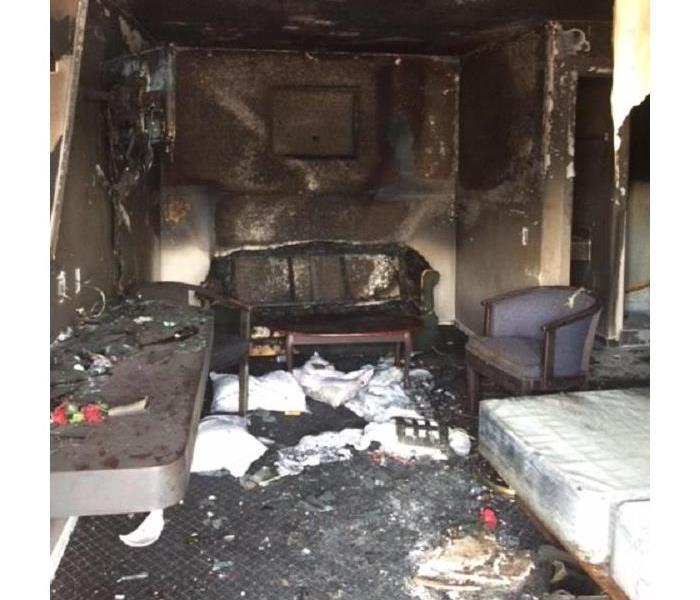 Let the professional assess the situation, and come up with a game plan to battle this fire damage.
Let the professional assess the situation, and come up with a game plan to battle this fire damage.
If your home has suffered a fire damage, here are some Do's & Dont's to help prevent further damage:
DO:
- Limit movement in your home to prevent soot particles getting embedded into your carpet or rugs.
- Saving the plants? Wash both sides of the leaves with milk. Milk neutralizes the acidic soot particles.
- Carefully wipe soot from chrome on appliances and faucets.
- Place cheesecloth over air registers to help keep soot in or out of your HVAC system.
DON'T:
- Touch drywall with your fingertips. The oil from your hands can set the stain permanently.
- Try to wash walls, ceilings or other painted surfaces. Again, this could actually set the stain.
- Turn on any ceiling fans if the ceiling is/was wet. The wiring may be damaged, causing an electrical shock. And, air movement may create secondary damages.
- Consume any food or medications that may have been affected by flames or heat. These may be contaminated.
SERVPRO Bedford Park / Burbank has trained personnel dealing with fire / smoke damages.
From drying structure and contents left behind by the firefighters, to cleaning up fire extinguisher residue, to removing smoke odors, a simple call to 708-430-3600 can get the process started!
Different types of fires
5/15/2017 (Permalink)
 No signs of structural damage, but there is some smoke/soot damage in this room.
No signs of structural damage, but there is some smoke/soot damage in this room.
All fires are unique, from the different ignition sources to the types of materials and structure affected. The trained staff at SERVPRO of Bedford Park / Burbank can determine the type of fire and the best way to clean it up.
Different types of soot
A fire that mostly wood and paper products burn will have high heat and will create a dry soot; lots of ash that is relatively easy to clean. Think of a fireplace once the season is over, and you have to clean the ash that is left over.
A fire that has lots of rubber or plastic products that burn will have a stickier residue with a more pungent smell. This type of soot is harder to clean, and also tougher to get the odor out.
If you have a fire that has animal fats and/or proteins (like leaving chicken to cook on the stove and then forget about it until it's too late), that fire leaves a very sticky and smeary type of soot that is very difficult to clean and deodorize.
Don't take a chance trying to clean smoke or soot damage yourself; trust the experts at SERVPRO of Bedford Park / Burbank to come out and assess the damage and determine the best course of action.
Major causes of home fires
4/11/2017 (Permalink)
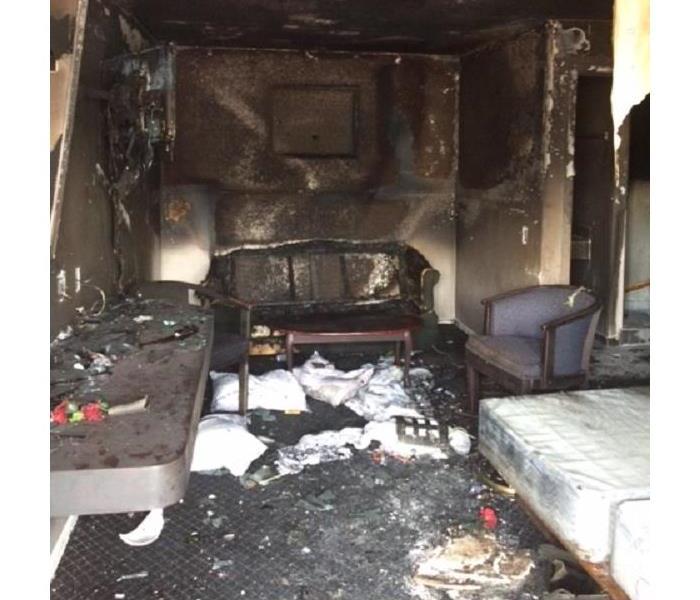 This room may not have been directly in the flames, but is covered in soot.
This room may not have been directly in the flames, but is covered in soot.
There are about 365,000 home fires every year, continuing a steady decline from the 1970’s, when there were about 723,000 home fires in the US.
Below is the list of causes of home fires in the US:
#5 Appliances. They account for nearly 14,000* fires every year. When was the last time you cleaned out the back of your dryer and not just the lint trap?
#4 Smoking. Smoking accounts for more than 17,000* fires every year in the US. If you must smoke, extinguish and properly discard your materials.
#3 Electrical. Electrical fires account for more than 28,000* US home fires annually. Is that old extension cord frayed or safe?
#2 Heating. More than 57,000* US home fires are traced back to heating causes. Space heaters placed too close to combustible objects are just one of the causes. Fireplace rollouts are another cause.
#1 Cooking. Cooking fires make up more than 160,000* fire calls each year in the US. Unattended cooking is one of the major causes of this fire.
Ask yourself these questions: Are all the smoke detectors in the house working properly? When did I last test them or change the batteries? When was the last time the fire extinguishers were checked?
* NFPA figures.
What you need to know about cooking fires!
12/2/2016 (Permalink)
 Customer contacted us after they experienced a cooking fire. Thankfully everyone is fine and they are letting us to take care of the soot/smoke damage
Customer contacted us after they experienced a cooking fire. Thankfully everyone is fine and they are letting us to take care of the soot/smoke damage
Is that time of the year! During the holiday season, “cooking” is the leading cause of home fires and home fire injuries. Since more fires start in the kitchen than in any other part of the home it's important to be alert to prevent cooking fires!
Let’s stay safe. Follow these easy safety tips, courtesy of the NFPA National Fire Protection Association:
What you should know
- Be on alert! If you are sleepy or have consumed alcohol don’t use the stove or stove-top.
- Stay in the kitchen while you are frying, grilling, boiling or broiling food.
- If you are simmering, baking or roasting food, check it regularly, remain in the kitchen while food is cooking, and use a timer to remind you that you are cooking.
- Keep anything that can catch fire — oven mitts, wooden utensils, food packaging, towels or curtains — away from your stove-top.
If you have a cooking fire
- Just get out! When you leave, close the door behind you to help contain the fire.
- Call 9-1-1or the local emergency number after you leave.
- If you try to fight the fire, be sure others are getting out and you have a clear way out.
- Keep a lid nearby when you’re cooking to smother small grease fires. Smother the fire by sliding the lid over the pan and turn off the stove-top. Leave the pan covered until it is completely cooled.
For an oven fire turn off the heat and keep the door closed.

 24/7 Emergency Service
24/7 Emergency Service

































